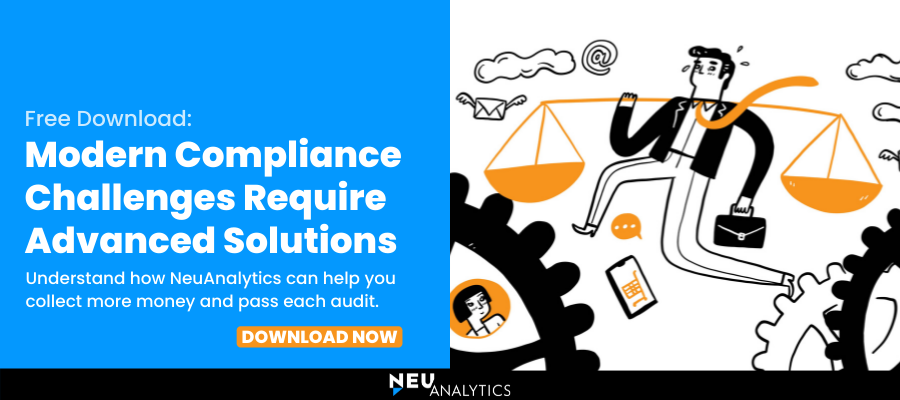As a creditor, a risk management framework is a crucial part of your receivables processes. Each of the various regulators in the financial services industry has its own rules on managing risk, but the theme for all of them is generally the same. They want each creditor to have a formal risk management process in place which is approved by the board of directors, which helps demonstrate to them that the entire organization is aware of, trained, and on board with how risk is managed and mitigated.
From there, the compliance management system will contain the processes that govern how a creditor handles auditing, monitoring, and mitigating risk for its third parties, including collection agencies. A key part of this is analyzing the risk a given agency brings to the relationship, and what elevated risk might come into play if problems arise: Is a specific third party worth the risk? Do the benefits of the relationship to us as a creditor and to our customers outweigh that risk? What happens if you need to replace a vendor?
In each contract between the creditor and third-party vendor, risks are stated and language defines how the vendor will work to mitigate those risks. For a collection agency, a primary risk is that a collection representative may not know the required regulations, or for some reason may not abide by them, resulting in harm to a consumer.
If your third-party collection agency has employees that violate regulations, that’s a problem for you. They might be sued, and you might be dragged into those legal proceedings because you’re expected to monitor how they do their work on your behalf. You are ultimately responsible–and may be liable–for how they do what you’ve hired them to do, a concept called “vicarious liability” that applies to any vendor you engage with.
With an established process in place governing how a creditor audits third-party vendors, staff is then charged with constantly monitoring the compliance and risk management process and updating it as laws change. Whenever something occurs that doesn’t comply with the process, there must be a response. Generally, if you have a process, identify problems when they occur, and respond to fix the problem, regulators look at inadvertent, mistaken violations of regulations in a more favorable light.
Managing Collection Agency Risk
When an account goes bad, it’s charged off and goes to collections. It’s up to each creditor to decide how to handle the risk management required for the relationship they have with each collection agency. Some choose to handle risk management internally, while others choose to work with an external risk management partner.
Either way, there are frameworks regulators require you to have in place and follow. You need a formal process that addresses the main items the regulators require, and you must have an effective monitoring system to find any and all violations.
Internal Risk Management
Internal risk management is when creditors take on risk management themselves. They build their own compliance management system and assume the responsibility of ensuring their collection agencies are compliant with laws, avoiding or quickly and effectively detecting and resolving any violations, doing all their own audits, and more. Done effectively, they can keep consumers happy and stay in the good graces of regulators. Done poorly, the ire of consumers who’ve experienced violations and the scrutiny of regulators charged with enforcement mean the legal ramifications and financial consequences can be substantial.
External Risk Management
Creditors that choose an external risk management system to select an organization, often a technology provider like NeuAnalytics, that acts as an intermediary to help them manage and monitor their third-party collection agencies.
Internal Risk Management Downsides
The thought of keeping your risk management internal might be tempting. You may think it’s a way to save money and maintain control. You can review your contracts, manage board oversight, and handle problems you are aware of; but the prospect of managing and monitoring each and every account you have placed with a collection agency can be daunting.
With so many different software systems in use by collection agencies, it’s challenging to bring in and combine large volumes of data from different vendors, and then turn that into something cohesive, useful, and understandable.
For most creditors, the only chance to stay on top of collection agency risk is to monitor and audit a representative sample of accounts. In most cases, agencies do this work manually. The problem is, even if you’re a smaller- or moderately-sized creditor, sampling even as little as 10 percent of your accounts with each agency means manually auditing thousands of records, which quickly becomes an overwhelming amount of work.
That leads to the temptation to take an even smaller, more manageable sample – let’s say one percent. While that may give you a more reasonable amount of auditing work to do, it’s nowhere near a representative sample. You’re glossing over the vast majority of accounts, a decision that comes with considerable risk because you just don’t know what’s happening with 99 percent of your accounts.
A significant portion of the violations that are flagged, and a substantial number of the situations that bring the scrutiny of the CFPB, stem from just one or two instances out of tens of thousands, even millions of accounts. Likewise, a good portion of the class action lawsuits we see also start with just one or two unhappy consumers. Finding the needle in the haystack can be nearly impossible when just sampling accounts for auditing.
External Risk Management Benefits
An external risk management solution must take those same processes and not only automate them, but do so more efficiently and effectively. Where creditors managing risk internally require large teams of people working to audit a representative sample of their accounts, a quality risk management solution should be able to produce clear, concise reports at any time. Automation ensures nothing is overlooked, no violations are missed, and any missteps are quickly identified and addressed. That reduces your risk, and your legal exposure, protecting the reputation and financial stability of your organization from costly fines and class-action lawsuits.
NeuAnalytics’ Integrated Support Platform can monitor millions of accounts and identify problems that need to be resolved. For example, it’s not unusual for our clients to have over a million accounts in collections at any given time, each account is monitored for more than 100 different potential violations, resulting in billions of audits happening daily across our client base. We blend all the relevant data from your collection agencies and their various platforms and deliver it to you in a form that makes it easy to review and act on immediately. You’ll also get the tools you need to document your compliance process from beginning to end, including corrective action plans and exception clearing.
We specialize in this type of managing and monitoring third-party risks for creditors. Our decades of experience in the industry and our ability to automate the process and deliver it as an always-up-to-date SaaS offering means nothing is overlooked.
NeuAnalytics: Your best protection against collection-agency-related fines and consumer lawsuits
Our fully automated monitoring system reviews all your accounts daily, checking for hundreds of possible violations across all your third-party collection agencies. Don’t burden your staff with an overwhelming amount of manual auditing work that never ends when there’s a fast, affordable solution that gathers data from every different agency platform and presents it in a format that is easily understood and clearly actionable. Contact us today to learn how our NeuAnalytics suite of solutions can provide you with a customized solution to make your risk management faster, easier, and more accurate.
For additional information on compliance solutions available through NeuAnalytics, download:

